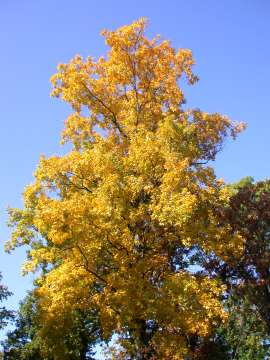

Carya glabra - (image 1 of 8)
Taxonomy
Family: Juglandaceae
Habitat
Dry upland woods. Not tolerant of shade.
Associates
Distribution
Southern VT and southeast NH west to MI, southeast IA and eastern KS, south to FL and eastern TX.
Morphology
Deciduous tree usually not much large than 20 m but occasionally to 45 m. Bark gray, becoming fissured with age with intersecting ridges that create a distinctive diamond pattern. Leaves pinnate compound; leaflets 5-7, most often 5, margin glabrous, hairless. Terminal buds up to 1.2 cm long. Bud scales imbricate, gray. Fruit pear-shaped, 4 ridged, slightly flattened; shell moderately thick; kernel bitter.
Notes
Flowers early May to mid June.
Wetland indicator: Facultative Upland
Apparently not the most common of hickories. Very nice yellow fall color.
Quite similar to Carya ovalis (Wangenh.) Sarg. and it can be difficult to separate the two; the bark of C. ovalis, or Red Hickory, forms fairly long plates; the leaves most often have 7 leaflets and red petioles; the nuts are edible and somewhat compressed and angled above. Has been called C. glabra var. odorata (Marsh.) Little.
References
Farrar, J. L. 1995. Trees of the Northern United States and Canada.
Ames, Iowa: Iowa State University Press
Gleason, Henry A. and A. Cronquist. 1991. Manual of Vascular Plants of
Northeastern United States and Adjacent Canada. Second Ed.
The New York Botanical Garden. Bronx, NY
Hardin, J.W., D. J. Leopold, and F.M. White. 2000. Harlow and Harrar’s Textbook of Dendrology. Ninth Ed.
McGraw-Hill. New York.
Swink, F. and G. Wilhelm. 1994. Plants of the Chicago Region.
Indiana Academy of Science. The Morton Arboretum. Lisle, Illinois.
|
© Michael Hough 2004 |